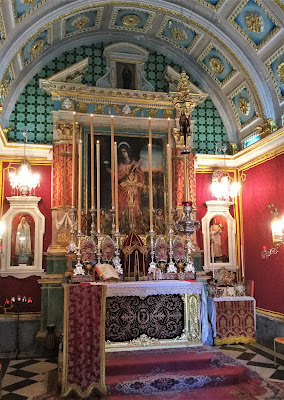Saint Lucy lived in Sicily in the 4th century and was known
for her kindness and generosity, although as with many saints, she had a tragic
history. According to legend, she sailed from Italy to Sweden during a famine
on a ship laden with gifts of food and drink and promised the return of the
light, spring, and abundance. In turn, the grateful Swedes took up the practice
of celebrating her feast day, creating their own traditions along the way.
On the morning of December 13, the eldest daughter of the
household rises early and dons the dress of the "Lusibrud (Lucy
bride)," white robes with lace trimmings and a red sash and a special
crown of ligonberry twigs and holly adorned with white candles. (In the past
the candles were lit, but due to safety concerns, the candles are now battery‑powered.)
She walks around to each member of the family with a pot of coffee and a tray
of gingerbread cookies and Lussekattor ("Lucy cats," saffron buns)
while singing. The younger daughters carry lit candles and the sons accompany
them, dressed as "star boys," male helpers of the saint in white
pyjamas and hats with a gold star. In some villages, the Lucy bride went from
house to house and bonfires were lit as "Lucy fires" into which
incense was tossed for good fortune.
St Lucy herself was from Siracusa, Sicily and was forced
into prostitution after she refused to marry a pagan, mostly forced on her by
her mother. The Emperor punished her by sending her to prostitution, but when
they came to carry her, they found her as heavy as a mountain. Then they started
to torture her, eventually even plucking her eyes, which were beautiful. She had
also predicted the end of the persecutions, which actually came to an end 9 years
after her death in 313 AD. Saint Lucy is
the patron Saint of those suffering from eye ailments, like cataracts or
glaucoma.
Just today I was asked to celebrate Mass at a small chapel dedicated to Saint Lucy at Naxxar, and as is customary, it was dressed up in its finest outfit with decorations and 6 statuettes of 6 female martyrs, St Philomena, St Cecilia, St Lucy, St Agatha, St Agnes and St Catherine.
Just today I was asked to celebrate Mass at a small chapel dedicated to Saint Lucy at Naxxar, and as is customary, it was dressed up in its finest outfit with decorations and 6 statuettes of 6 female martyrs, St Philomena, St Cecilia, St Lucy, St Agatha, St Agnes and St Catherine.
 |
| Chapel of St Lucy, Naxxar, Malta |


St.Lucy pray for me.
ReplyDelete